The classic LL Bean original Bean boots have been gracing the feet of outdoorsmen, preps, and hipsters for over 100 years. As classic style enthusiasts, we share an honest review of the famous boots in this installment of our ever-expanding “Is It Worth It?” series.
Usually, here at the Gentleman’s Gazette, we dedicate more of our content space to formal and dress boots. But, as you’ll see in Raphael’s personal boot collection, you benefit greatly from having a wide variety of boots available to tackle all kinds of weather, especially when you live in snowy Minnesota, as we do. Let’s learn more about Bean boots, and you’ll see exactly what we mean.
History of LL Bean

Believe it or not, the original Bean boots actually predate LL Bean as a company. Leon Leonwood Bean was an avid sportsman and outdoorsman living in Freeport, Maine. During long hikes and hunting trips, Bean would notice that water would slowly seep into his leather boots, making his feet damp and cold. Bean resolved to fix the problem, and in 1911, he worked with a local cobbler to combine the upper leather portion of a hunting boot with the foot portion of a rain boot.
Bean originally called his new creation the “Maine Hunting Shoe,” although they were also known by the generic nickname “duck boots.” In 1912, Bean founded the LL Bean Company, selling his new boots out of a one-room warehouse as a mail-order product, marketed primarily to hunters in the Northeastern United States.


Disaster struck, however, when a flaw in the original design caused the boots to fail after extended use. By some estimates, up to 90% of the boots sold by Bean at that point were returned, and Bean insisted that every single pair be refunded or exchanged.
This example of standing behind the product proved to be a marketing boon for Bean, and the LL Bean reputation for quality assurance and a robust satisfaction guarantee quickly became a selling point for all LL Bean products.
In 1917, LL Bean opened its iconic flagship store in Freeport, Maine. Famously, the stores have stayed open 24 hours a day since 1951, excepting national emergencies and days of mourning for members of the Bean family.
In 1934, LL bean was doing a brisk business nationally, and Bean expanded operations and entrusted most of the work to members of his extended family. In 1946, LL Bean’s gross sales exceeded one million dollars, and it almost quadrupled by 1967, when Leon Leonwood Bean died, the company passed to Leon Gorman.

The founder’s grandson continued an earlier trend of expanding LL Bean offerings to include other footwear, clothing, and outerwear with a primary focus on the original Bean boot. LL Bean continued to grow, with gross sales topping $20 million in 1974 and $235 million in 1984.
In the 2010s, Bean boots enjoyed a surge in popularity, pulled by the renewed interest in minimalist aesthetics and dependable products. Shortages were widely reported, and LL Bean eventually ramped up production to produce over 500,000 units annually.
In 2013, Leon Leonwood Bean’s great-grandson, Shawn Gorman, became chairman and extended members of the Bean family remain highly involved in the running of this company to this day.

For most of its history, LL Bean had kept in place its famous unlimited return policy, which allowed customers to return items at any time if they were dissatisfied. In 2018, however, Bean limited this policy to returns made within one year of purchase with proof of the original purchase. Bean claimed that they have been forced to change this policy because people had been abusing it. For instance, demanding returns on products with normal wear-and-tear.
Today, the LL Bean Company enjoys an annual revenue in excess of 1.5 billion, maintains over 50 store locations, and employs over 6,000 people.
LL Bean Ethos and Industry Position Today
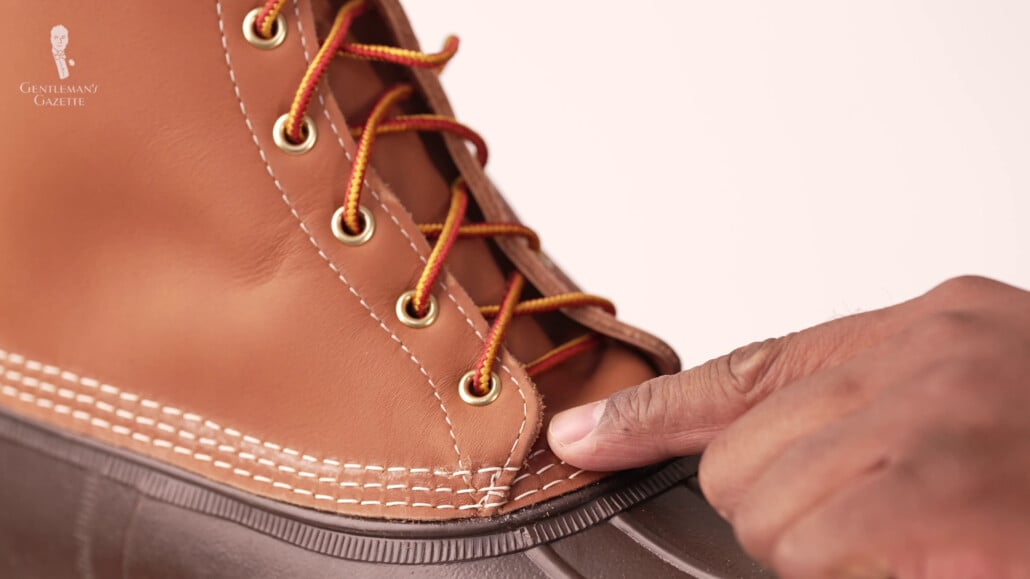
Despite alterations to his famous satisfaction guarantee, LL Bean remains closely associated with an Americana aesthetic that is trustworthy and dependable. Relying on simple lines, neutral earth tones, and rugged silhouettes, especially in their boot lines. The emphasis on practical styling truly suited for nature originally cemented the popularity of LL Bean styling with outdoorsmen, hunters, and the sporting set.
By the middle of the 20th century, the charm of the LL Bean boots spread, particularly to affluent young men, who wore Bean boots while adventuring out from their lighthouses and trekking to secluded cabins. These Bean boot enthusiasts brought their boots back to civilization, causing Bean boots to proliferate on college campuses and resort towns and across suburbia, along with clothing from Abercrombie & Fitch and Duck Head.
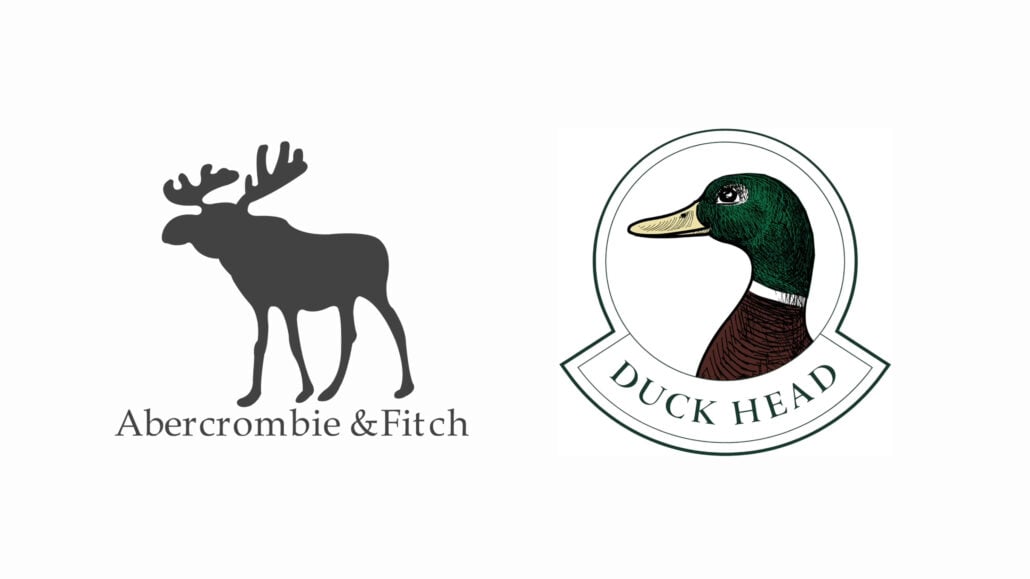
Bean boots soon became an important part of the athletic, rough-hewn, and outdoorsy aspect of the prep style. So much so that, in a satirical 1980 official Preppy Handbook, LL Bean stores were declared nothing less than a “Prep Mecca.” The company even earned a mention in Robert Lowell’s 1956 poem “Skunk Hour.”
“The season’s ill – we’ve lost our summer millionaire, who seemed to leap from an LL Bean catalog.”
Robert Lowell
Today, Bean boots are worn by a variety of men, from preps to hipsters to workmen to hikers, who all seem to be drawn to the very simple business model: simple styles with quality materials and versatile palettes.
LL Bean Boots Overview
Today, LL Bean offers a wide variety of specialty boots and shoes, but this review is only on the original.
The original LL Bean boot currently retails on the LL Bean website for $149. In both the classic tan and brown and basil and black. You can also get the shorter 6-inch model for $139.
Sizing


[Images Credit: LL Bean]
The boot is available in American sizes 7 through 14 with narrow, medium, and wide widths. Hopefully, Bean offers a rather detailed explanation of how to select the correct size based on your preferred socks. But, with a somewhat less helpful caveat that Bean boots are uniquely sized, and you may need to size up or down.
Construction
When detailing the construction, LL Bean emphasizes that their shoes are made to last in American factories. The two major factories are in Brunswick and Lewiston, Maine. We have a separate guide about how the country of origin affects product quality. But Bean offers a fairly detailed look at the production process on their website, including that their workers undergo a minimum training period of 26 weeks.
Does “Made In” Matter? Countries of Origin for Menswear Products
Features
Bean identifies their leather as premium full-grain, which is useful to know. But a bit more information would have been appreciated. Similarly, there’s no explanation for what “high-quality rubber” actually entails. A greater interest is their emphasis on triple-stitched construction and the use of a steel shank for support and structure.

In addition to the obvious feature of leather uppers with a rubber foot, Bean boots have a number of other features. Laces are strung through metal-supported eyelets with a reinforced tab to help you pull the boot onto your foot. The outsole has a unique chain-thread texture to help improve traction in wet conditions. Basically, these are the features you’d expect to find on a boot of this kind. But, again, at this price point, it’s clear that Bean only wants to do the simple things and do them well.
Original Bean Boot Variations
Bean has released two basic variations on their original boot. The Gore-Tex/Thinsulate model is designed to be even more water-resistant and insulated without increasing weight. This is achieved with the use of patented Gore-Tex lining and ventilated insulation made from olefin polyester. These additions come with an increased price tag of $229.

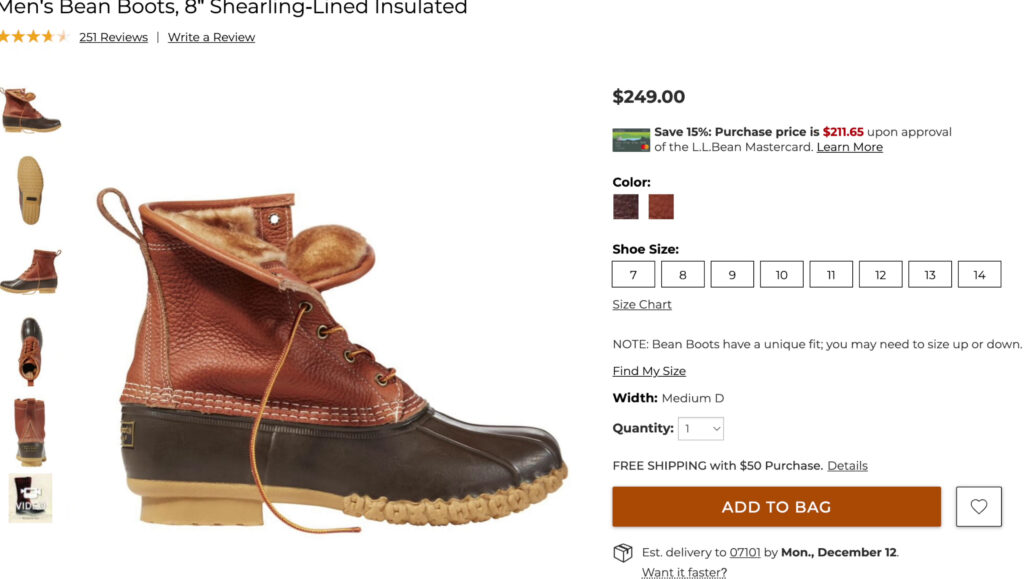
The other variation is intended for cold weather use and features a shearling-lined upper section with 200-gram PrimaLoft insulation in the lower portion. The leather on this model has also been tumbled for a more broken-in, comfortable feel.
Our Assessment
Now that we’ve met the contenders, how do they stack up? Let’s assess each boot for quality with an emphasis on the quality hallmarks mentioned in our Boots for Men guide.
Boots For Men – What Styles You Should Buy & What Mistakes To Avoid
Original Boot
When trying on the original boot, I found that they fit fairly well, but I can see the point of how sizing down or perhaps wearing thicker socks would be ideal. I found that it was very easy to put on and off, especially with the helpful pull tab.

The style is very easy to integrate with a casual ensemble. Colors offer a great natural base to blend with a variety of colors. The throat of the boot does not fit under my pant leg too well, in part due to the design; also due to the style of pants that I typically wear.
The boots feel secure when laced – not too tight – but then, again, I am wearing thinner socks. I feel like I could walk a portion of the day in these boots with no problem. The support from the steel shank is great to have – not intrusive or uncomfortable.
The boot doesn’t feel exceptionally warm, but it’s fairly comfortable. The boot feels comfortable to wear during fall conditions. It may also be an option during mild winter conditions. But I personally would prefer something warmer during the height of winter.

Durable and Comfortable
The leather feels durable and feels of decent quality.
The leather feels durable and comfortable and feels of decent quality. The heft and weight are great. It makes the comfort and quality noticeable. I found the stitching to be very neat, bold, and sturdy. The laces appear to be of decent quality. But, a question on how they might hold up to moisture over time? They might start to fray. The laces appear synthetic.
Shearling-Lined
Because the Gore-Tex/Thinsulate and shearling variations are both intended for cold weather wear, we decided only to test the shearling.
Unfortunately, we did not find much to love about the shearling-lined variation. The addition of the shearling clearly indicates that the boot is marketed for cold weather use, but it didn’t stand up to our Midwestern winters because only the upper portion is shearling-lined.
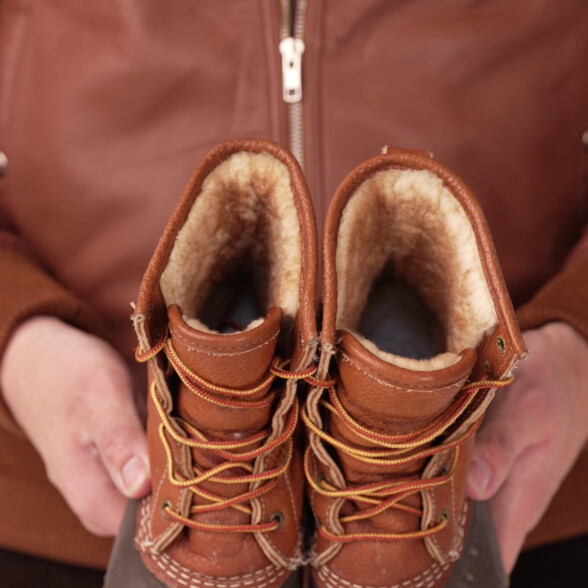
The addition of the shearling clearly indicates that the boot is marketed for cold weather use, but it didn’t stand up to Midwestern winters because only the upper portion is shearling-lined.
The rubber portion of the boot allows a considerable amount of cold. In cold temperatures, the PrimaLoft insulation did essentially nothing, neither keeping off the chill nor insulating heat. The shearling also created a catch-22 situation.
Because the rubber portion is so cold, you have to wear thick warm socks, but those same socks create an extremely heavy, stuffy situation at the ankle, where the shielding is. This leaves your ankle feeling hot and sweaty while your feet and toes are chilly.


The rubber sole also proved extremely treacherous in icy conditions, making the boots very slippery, especially as the textured portion of the rubber sole wears down fairly quickly, reducing grip.
The laces on this model were also very cumbersome, becoming tight and difficult to remove after wear. Essentially, the laces had to be almost completely loosened before the boot could be pulled off, necessitating a total re-lacing before the next wear. If you’ve got somewhere to be, all that lacing and unlacing can be a real drag and a waste of time.

One thing we did like about this model was that, despite the bulk around the shearling lining, the cuff, when laced, laid very tightly against the leg. This prevents bunching at the trouser cuff and leg, which is a common problem with winter boots.
Overall, while this boot variety is marketed for the extreme cold, we do not find it useful for wear in temperatures below 40 degrees Fahrenheit.
Conclusion
So, did we find that Bean boots are made for walking, or should they be kicked to the curb? The exciting factor in this decision is how you intend to use them.

With their good construction and innovative, hybrid leather-and-rubber materials, the Bean boots performed admirably in rainy and wet conditions. It was clear that they were designed for wet climates.
While we consistently found that they weren’t well-suited for extreme cold or snowy conditions in our region, we inspected that they do very well in the typical conditions found in the American Northeast, where, not coincidentally, they are originally conceived and designed.
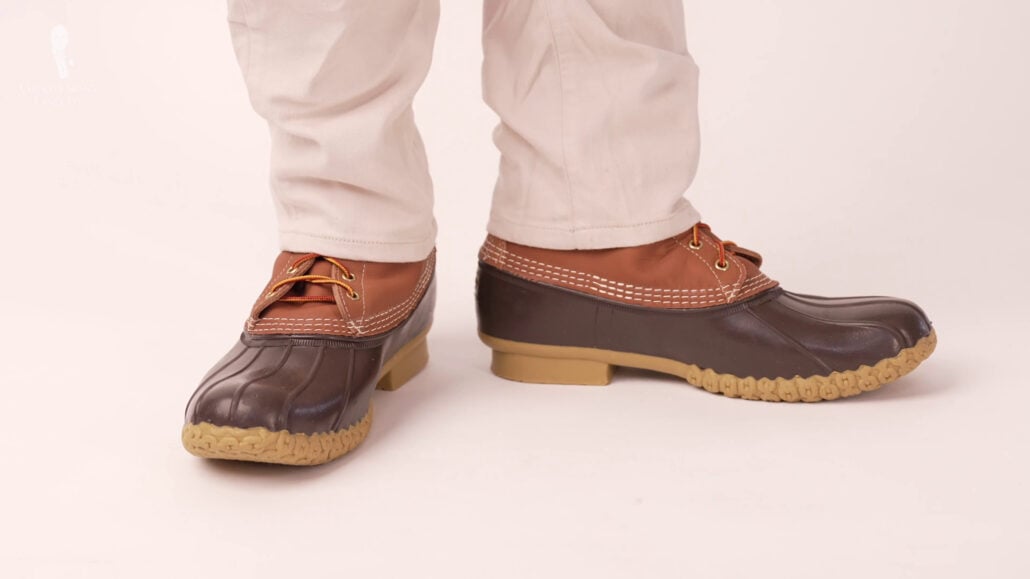
Bean boots also have a simple, timeless, minimalist, classic cut with a somewhat-charming dad aesthetic. This makes them very versatile and very easy to integrate into casual ensembles. Because these boots are relatively comfortable for walking, have a tight throat that sits securely against the leg, and are resistant to rain, we think that they can be especially useful as a commuter boot, especially if you live in a wet city that doesn’t get extremely cold and you do a lot of walking.
In warmer climates and transitional seasons and colder climates like the American Midwest, Bean boots seem well-suited to effectively being a quality rain boot and a good alternative to Wellingtons.

We do not, however, recommend the Bean boot as a winter boot unless you have very mild winters. The rubber portion makes the boot extremely cold and potentially dangerous in icy conditions. When it comes to winter boots for serious winters, we’d recommend investing in something more substantial instead.
We’d also note that Bean boots don’t have a very elegant silhouette. They’re definitely not dress boots. So, while they’re a nice compliment to casual, collegiate, and preppy looks, they might not integrate well into more refined ensembles.
With all that being said, if they can work with your wardrobe, Bean boots are a very impressive value. It’s very unusual to see boots of this quality – made in America, no less – retail for less than $200.
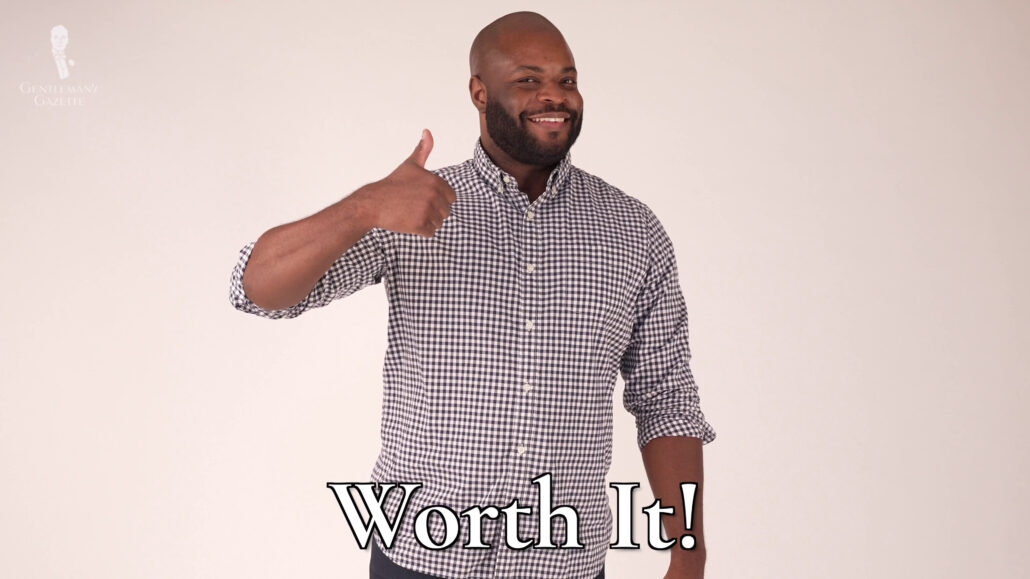
Although we’re sorry that LL Bean had to discontinue its lifetime guarantee policy, it’s clear that the company still stands behind its product. We appreciate its very responsive and dedicated customer service program.
Therefore, we conclude that Bean boots are worth it if you wear them in transitional seasons or have mild winters, you’re primarily interested in a boot for wet environments, you can integrate the boot into your larger personal style, or you can utilize it as a commuter boot.
Now that you’ve heard our views, we want to hear yours. In your opinion, is the original Bean boot worth it or not?
Outfit Rundown
Today, I’m wearing a navy cable-knit sweater, a red and white striped long-sleeve shirt with a pair of off-white jeans, and, of course, a pair of Fort Belvedere socks. And finishing off the look today is the original Bean boot. Check out the Fort Belvedere shop for socks like these.
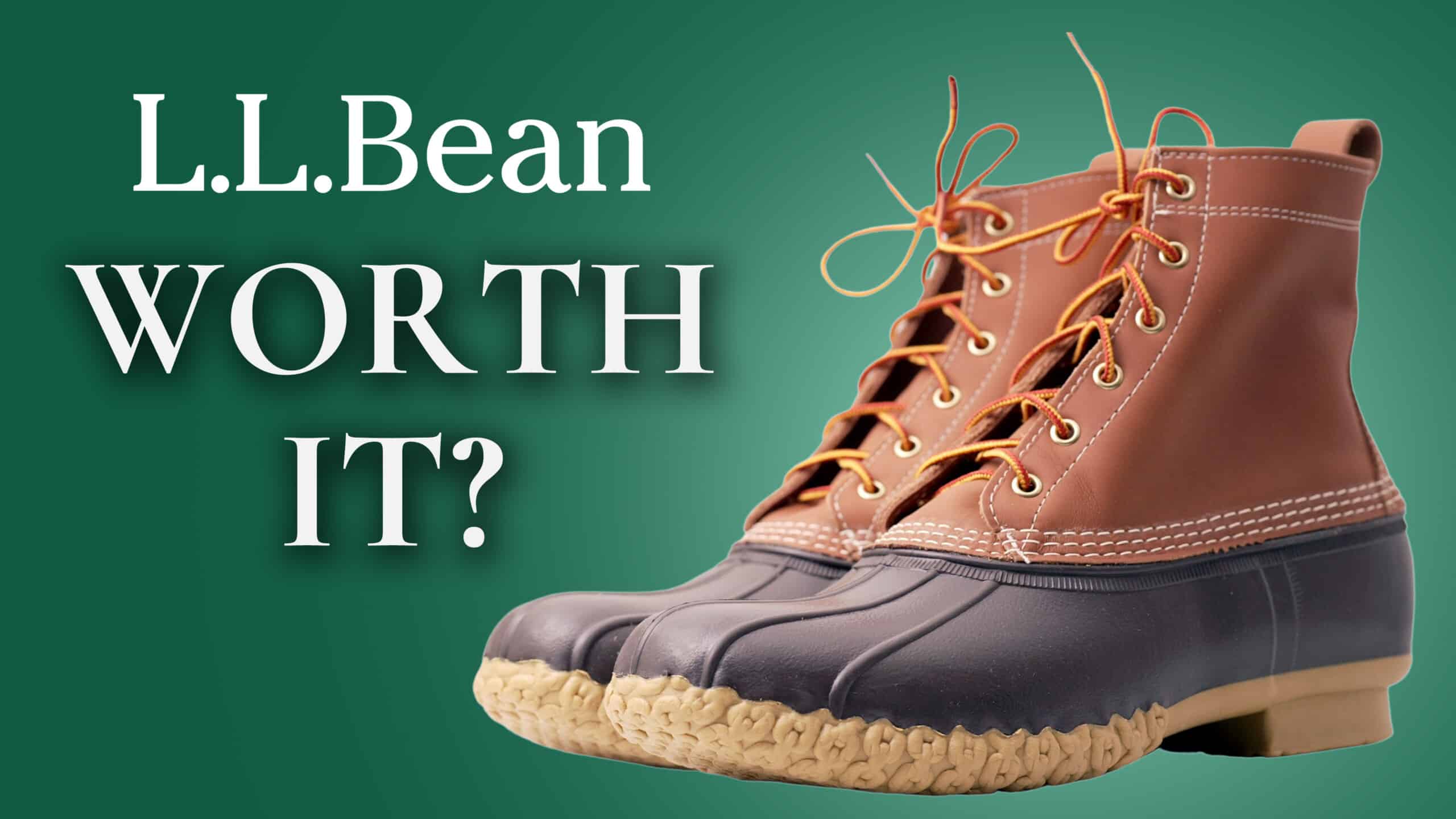



They don’t have Fall season in Minnesota like in the Northeast or does it constantly snow year-round?
If you could wear it in the Fall in the Northeast, couldn’t you wear them in Minnesota in the Fall as well?
I agree, not a “cold weather boot”. I have two pairs, one the lace up 6″ and the slip on. . I bought a pair some time ago and they were too big. I only wore them 1 or 2 times in my home, not outside. For whatever reason, I forgot to call initially to see if I could return them for a smaller size. They were still in the box and almost 11 months went by when I returned them.
The customer service lady told me I could return them in exchange or get my money back. An amazing company! Made in America is a plus too. their quality of clothing is great too.
I bought a pair of the regular boots about 1990. Far too cold for winter wear in Cambridge, MA, and a bit too roomy. Both were fixed with a pair of shearling insoles. The rubber bottoms sprang a leak after about a dozen years, and I replaced this pair with a pair of insulated Bean boots from a factory outlet store (they had just released the Thinsulate line and the ones I bought were discontinued, so I got a good deal) and they were perfect for about fifteen years, when once again the rubber bottoms sprang a leak. The factory outlet store near me charged about $55 for a bottoms-only replacement – snugger, and now with Thinsulate; a fantastic deal. And my winter boots march on.
“The rubber portion of the boot allows a considerable amount of cold. In cold temperatures, the PrimaLoft insulation did essentially nothing, neither keeping off the chill nor insulating heat.”
Cold is not a phenomenon in its own right but is simply the absence of heat. You can let in cold air, but “letting cold in” just means letting heat out. They’re not two different things.
I’ve been wearing them since college (long ago, when the label on the heel actually said “Maine Hunting Shoe” rather than “Bean Boots”). The thinsulate-lined version is MUCH warmer than the unlined version and I’ve had the same pair for years. For city dwelling (I live part time in NYC and part time outside DC) ) I prefer the Bean gum shoe, which is the same family as the hunting boot, but with a more cut down leather upper – I find it segues a bit better with my trousers and is proof against all but the deepest slush and puddles. I’m a True Believer.
I am 59 years old and have been wearing LL Bean hunting boots since I was 16 years of age. They are well worth the price, in my opinion, especially for the original purpose of the boots; hiking and hunting in wet, inclement weather. Having grown up in the Appalachian mountain region of Western North Carolina, in the woods as well as about town, I have found them to be comfortable and stylish when worn with both traditional hunting attire and lightweight corduroys and Celtic tweed waistcoats with English style waxed jackets.
I live in New England and love them, they’re perfect for the climate here. A quick note about the laces – they last for a long time. Great with jeans, not too preppy or too dressed down and don’t interfere with your pant leg, as the article says. You can slip them on and off to run outside quick in the colder seasons or rain too, which is nice when you’re grabbing the newspaper or running to the garage quickly. I would say the thinsulate lined version are worth the extra and have a more stylish lining too.
I have a pair of the 8″. Where I am in Canada, they are a late spring to late summer boot. I wouldn’t trust the sole on ice. I wear them occasionally to run errands on rainy days, but that’s it. Doing yard work with them on is pointless. I prefer my Iron Rangers for outdoor work as they are considerably more protective. The bottoms of the Bean boots are no different than a regular rubber boot you can get in a hardware store. I can see a metal rake tine cut these easily. Yes, the bottoms can be replaced; however, the shipping along with the replacement cost isn’t worth it (for me at least). They have a place in my shoe/boot collection as a novelty rather than a “go to” article of clothing.
Great review. I have a pair of the original Bean Boots that works well for me. I bought them mainly when I need to go out and run errands in the rain where I’m in and out of the car. They’re perfect for that purpose as they keep my feet dry. However if I’m dressed up I wear my brogues with Dainite rubber soles as they look nicer than the Bean Boots.
I no longer live in a cold climate having moved to Nashville from Chicago, but I can see they would not work well for keeping your feet warm. As recommended in the video they do work well for milder winters such as what we have in Tennessee.
I had briefly considered getting a pair with shearling, however after watching this review I’m glad I didn’t. Thanks again for another great video.